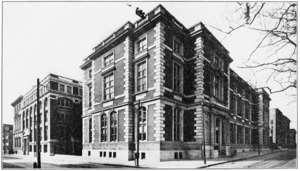List of natural history museums in the United States facts for kids
A natural history museum is a special place where you can explore the amazing world around us, from ancient times to today! These museums collect and show off all sorts of cool things like dinosaur bones, sparkling minerals, stuffed animals, and even plants. They help us learn about Earth's history, how life has changed over millions of years, and the different creatures that live on our planet.
There are natural history museums in every single state in the United States, plus Washington, D.C. The very first one, called the Academy of Natural Sciences in Philadelphia, Pennsylvania, started way back in 1812. That's over 200 years ago!
What You Can Discover at a Natural History Museum
Natural history museums are packed with incredible exhibits that teach us about science and the natural world. They often have different sections focusing on specific topics.
Dinosaurs and Fossils
One of the most exciting parts of many natural history museums is the dinosaur exhibit! You can see giant skeletons of creatures that lived millions of years ago, like the mighty T-Rex or the long-necked Brontosaurus. Museums also display fossils, which are the preserved remains or traces of ancient plants and animals. These fossils help scientists understand what Earth was like long before humans existed.
For example, the Field Museum of Natural History in Chicago is famous for "Sue," one of the most complete T-Rex skeletons ever found. In South Dakota, The Mammoth Site lets you see real mammoth skeletons still in the ground where they were discovered!
Animals and Plants
Many museums have amazing displays of animals from all over the world. You might see lifelike models or taxidermy specimens of lions, bears, birds, and even tiny insects. These exhibits often show animals in their natural habitats, helping you understand how they live and interact with their environment.
You can also learn about plants, from giant trees to microscopic algae. Some museums have special gardens or greenhouses where you can see living plants. The California Academy of Sciences in San Francisco has a rainforest dome filled with live animals and plants!
Rocks, Minerals, and Earth Science
Ever seen a rock that glows in the dark? Or a crystal that looks like a work of art? Natural history museums often have dazzling collections of rocks and minerals. You can learn how different types of rocks are formed, how volcanoes erupt, and how earthquakes shake the ground. Some museums even have meteorites, which are rocks that have fallen to Earth from space!
The A. E. Seaman Mineral Museum in Houghton, Michigan, has one of the best collections of minerals from the Great Lakes region.
Human History and Cultures
While focusing on nature, some natural history museums also explore human history and how people have lived on Earth. They might have exhibits on ancient civilizations, early human tools, or the cultures of different groups of people around the world. This helps us see how humans fit into the larger story of natural history.
The Phoebe A. Hearst Museum of Anthropology at University of California, Berkeley focuses on human cultures and history.
Famous Natural History Museums in the U.S.
There are many fantastic natural history museums across the country. Here are a few well-known ones:
- The American Museum of Natural History in New York City is one of the largest and most famous in the world. It has incredible dinosaur halls, a huge blue whale model, and exhibits on everything from outer space to ancient cultures.
- The National Museum of Natural History in Washington, D.C., part of the Smithsonian Institution, is another giant museum. It has over 145 million natural science specimens and cultural artifacts. You could spend days exploring it!
- The Denver Museum of Nature and Science in Denver, Colorado, is known for its dinosaur fossils and exhibits about the Rocky Mountains.
- The Houston Museum of Natural Science in Houston, Texas, features a huge dinosaur hall, a planetarium, and an insect zoo.
These museums are great places to visit with family or friends. They offer a fun and interactive way to learn about science, history, and the amazing natural world we live in!
Images for kids
See also
- List of science centers in the United States
- List of museums in the United States
- List of natural history museums
- List of university museums in the United States



